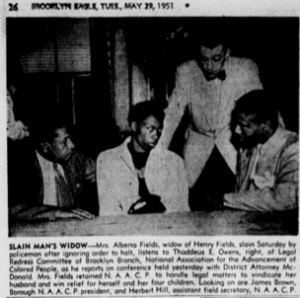A Gross Miscarriage of Justice

From the Brooklyn Eagle newspaper, Alberta Fields, widow of Henry Fields, the 26 year-old man shot and killed by the New York City Police in 1951.
On May 26, 1951 a twenty-six year old unarmed Black man was shot in the back by a New York City police officer. His name was Henry Fields, Jr. His father, Henry Sr., told newspapers that his son was a “good boy” who worked in a produce store on Osborn Street in Brownsville, deep in Brooklyn. Relatives said Henry Jr. had never been in serious trouble before. He died of the gunshot wound just blocks from his home.
The killing of Henry Fields might sound familiar. Fields was chased down by the police after committing a misdemeanor offense, and for it he was met with a sentence of capital punishment. Familiar too was the lack of consequences for the officer who shot Fields.
Fields was driving his brother’s car and had a fender-bender accident with another motorist. He fled the scene the accident, but was chased by motorists, including two officers in a patrol car. Not very far into the chase, Fields pulled over. The police said a flat tire stopped him. When Fields exited the vehicle, patrolman Samuel Applebaum, a military veteran with extensive firearms training, drew up his sights on the young man and fired a .32 caliber slug into his neck.
Fields was well known and liked in his community. As his lifeless body bled into the street, an angry crowd gathered. The police sent upwards of twenty patrol cars and more than that many cops to the scene. A local pastor was enlisted by the authorities to calm onlookers and prevent a riot.
Within twenty-four hours a call was put out to gather for a mass rally to protest the killing of Fields. Former Congressman Vito Marcantonio appealed to the District Attorney Miles McDonald that there be “immediate grand jury proceedings in the wanton killing.”
“This is the latest in a long series of police murders of innocent Negros,” wrote Marcantonio. “Police brutality is turning streets of New York into areas of official police lawlessness and terror.
One meeting to plan a political response to the killing drew over 1,600 people. Forty patrolmen and twenty-five plainclothes officers prowled around the community meeting.
Despite it being 1951, there was a grand jury investigation into Fields’ slaying. And here’s where it’s both a familiar and unfamiliar story. The events echo the recent actions of grand juries in Ferguson, Missouri and Staten Island, New York, but the inquiry into Fields’ murder also revealed a streak of independence in District Attorney Miles McDonald and his staff.
In June a Brooklyn grand jury declined to bring any charges against officer Applebaum. But rather than accept this decision, the District Attorney’s office, which had recently conducted investigations into police corruption and so knew well the problems within NYPD, including racism, lashed out at the grand jury. Assistant District Attorney William Siegel called the grand jury’s decision a “gross miscarriage of justice,” and shamed the member of the jury for acting “capriciously and contrary to the law.”
According to Siegel, there was more than enough evidence to bring the officer to trial for at least manslaughter. Siegel cited the fact that Fields was unarmed; that he was shot after committing nothing more serious than a misdemeanor; that multiple witnesses said Fields was exiting his car in an non-threatening manner when he was shot. Witnesses said the officer made no attempt to stop or apprehend Fields. He simply blew him away. In his appeal to the judge, the assistant DA also noted that officer Appelbaum’s testimony contradicted his expertise and familiarity with firearms. Appelbaum had previously dealt with armed suspects with less than lethal force, once even taking a loaded rifle from a man’s hands. Appelbaum told the grand jury that it all was an “accident.” He “involuntarily” drew his gun and pulled the trigger, and that the bullet bounced off a car and struck Fields.
For all these reasons, and surely because of protest pressure from the community for justice, the District Attorney took the unusual step of asking a judge for a second grand jury investigation into the Fields case, and the judge obliged. But the second grand jury agreed with the first, recommending no charges be brought. Here’s where the unrecognizable ends, and the story concludes with a familiar ring of a justice system beset by racial inequality. Even with a DA who actively sought an indictment of a police officer for killing an unarmed black man, an American grand jury declined to subject a cop to trial.

Thank you.